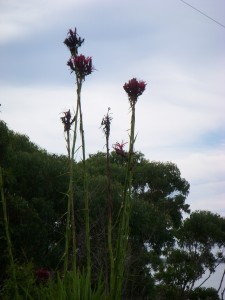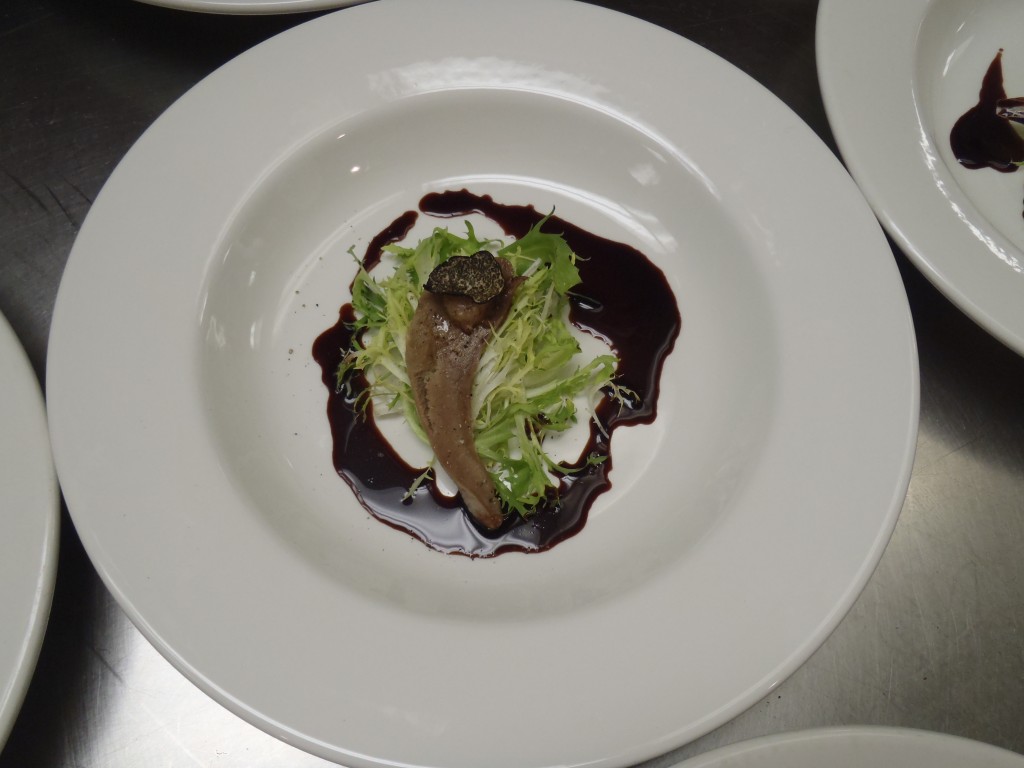I love creating plates that feature different components of the same ingredient: roasted beets with wilted beet greens, for instance, or pork loin and pork belly side by side. The truth is that no creature is capable of offering more variety at the dinner table than the triffid.
About Triffids

Triffids are interesting creatures. They are genetic hybrids, part animal, part plant. The precise intentions behind their development is uncertain, but researchers soon discovered that their oil is extremely useful and relatively cheap. Triffid oil has many industrial applications. It is also edible, and delicious.
As they are part animal and part plant, we can harvest a shockingly diverse set of food from triffids. Let’s talk anatomy.
The “Animal” Bits. Triffids perform three animalistic functions that require muscle tissue. First, they are capable of locomotion by way of three short legs. Just above the legs are a set of muscles called “clickers” that rap against the woody stalk of the plant to create sounds. The exact purpose of the sounds is still a mystery: most botanists agree it is a form of communication, though how exactly outside signals are received without ears remains to be understood. The third muscle group allows triffids to hunt, kill, and consume prey. At the very top of the triffid, on the “head,” there is a long, whip-like muscle called a lasher. At the end of the lasher is a venomous stinger. Triffids hunt by waiting for prey to come near enough that they can lash out and sting them. Small animals are killed almost instantly by a triffid sting. The triffid then hobbles towards the prey and waits for the flesh to decompose so that it can be digested (described below).
The “Plant” Bits. In addition to the three animalistic muscle groups described above, triffids also have all of the anatomy of a normal plant. When sedentary, triffids put down roots. They have a tall central stalk, called the trunk, which is usually about seven feet high. Near the head are more tender stalks that produce foliage. The head also contains a large cup filled with a sticky fluid, similar to that of a pitcher plant. Once a triffid’s prey’s flesh has rotted sufficiently, the triffid will use its lasher to lift the meat into this cup, where it is digested.
RaisingTriffids
The duplicitous nature of the triffid can make farming difficult: some practices promote the growth of the animalistic parts, while others encourage vegetative growth.
If prey is very scarce the triffid enters a vegetative state: it puts down roots, and gets all its energy from the sun. During periods of prolonged vegetation the meaty portions of the triffid are severely compromised. However, if the triffid is simply “fed” meat, it will not move about or hunt, and the muscles will similarly deteriorate.
While some producers seek to maximize the growth of either the animal or vegetable organs of the triffid, there are many artisinal producers that are striving to find a more sustainable compromise. This style of farming is very much a balancing act: to properly develop the muscles the triffids must not only be free-range, but also must be allowed to hunt for themselves; however, there has to be sufficient scarcity of prey that the triffids will take time to develop stalks, leaves, and other vegetable organs.
There are a handful of such triffid producers in Alberta, most of them in the Calmar-Thorsby area. They currently export most of their produce to the Asian markets, were it fetches a much higher price than at home. Right now you essentially have to know the producers personally to get their product. Hopefully their fantastic triffid meat, stalks, leaves, and oil will be available at farmers’ markets in Edmonton soon.
Cooking Triffids
As the legs are used for the protracted labour of standing and hobbling, the meat is relatively dark, similar to turkey legs. On farms, triffid stingers are pruned back (“cropped”) every year, usually in the spring. They are therefore extremely tender, a very seasonal delicacy. The small clickers are an intermediate texture and colour, similar to chicken wings. (These are very broad generalizations: the exact nature of triffid meat, as with any animal, depends largely on how it was raised, as discussed above.)
The trunk tends to be extremely fibrous, even in young triffids. In some parts of the world it is stewed, but even after extensive cooking most North Americans find it too woody. I like adding a bit of triffid trunk to piccalilli for texture. The trunk also makes a fantastic broth. I am convinced that the genetic make-up of the triffid includes some type of brassica, because the trunk and stalks have a distinct, slightly astringent mustard flavour. (It would make sense that these prodigious oil-producing creatures would be part brassica, like canola…)
The best vegetative parts of the triffid are the tender stalks that support the leaves, and the leaves themselves, which are similar in texture to kale.
One great way to showcase the many edible portions of a triffid is to make stir-fry. Triffid oil has a very high smoke-point. I heat the oil in a heavy pan until shimmering, then add cubes of leg and clicker meat. The pan will need to be very hot for the meat to brown. Then I add onion, garlic, ginger, and thinly-sliced triffid stalk. For the last couple minutes of cooking I throw in some slender pieces of lasher and triffid leaves, which wilt readily.
This week I was able to secure some triffid lashers from a producer near Thorsby. They were removed from the triffids just last week. I poached the lashers in a court-bouillon, then served them with bitter greens and balsamic vinegar. (Photo below.)
More than the pig, triffids truly should be the poster-child for the “nose-to-tail” movement. I hope the gastronomic importance of this creature is soon recognized by Edmonton’s restaurants and home-cooks.
So… even if you’re unfamiliar with John Wyndham’s science fiction novel The Day of the Triffids, it should be pretty obvious that this post is a joke for April Fool’s Day. Triffids don’t exist. All the anatomical details are from the book. The first picture is a photo of a plant in Australia from the travel blog mentioned in the caption. The second picture is actually a sliced lamb tongue, not a triffid lasher stump. Happy April 1st.
